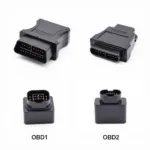OBD2 stands for On-Board Diagnostics, generation 2. It’s essentially a standardized system built into all cars manufactured after 1996 (in the US) that allows external devices, called OBD2 scanners, to access your car’s computer and retrieve valuable information about its health and performance.
Think of it like a window into your car’s brain. Just like a doctor uses various tools to diagnose your health, an OBD2 scanner allows mechanics and car enthusiasts alike to understand what’s going on under the hood.
How Does OBD2 Work?
Your car’s engine and other systems are constantly monitored by a network of sensors and computers. These systems collect and analyze data in real time, flagging any potential issues. This data is then stored in the car’s computer and can be accessed via the OBD2 port.
The OBD2 port, typically located under the driver’s side dashboard, provides a physical interface for communication. By connecting an OBD2 scanner to this port, you can tap into this wealth of information.
What Can an OBD2 Scanner Tell You?
An OBD2 scanner can reveal a wide range of data, from simple information like your car’s VIN (Vehicle Identification Number) to more complex diagnostics like:
- Reading and clearing trouble codes (DTCs): When your car’s “check engine” light illuminates, it means a fault code has been stored. The OBD2 scanner can read these codes and help pinpoint the issue’s location.
- Monitoring engine performance: Want to know your engine coolant temperature, RPM, or fuel system status? An OBD2 scanner can show you this data in real time.
- Analyzing emissions data: OBD2 scanners can monitor your vehicle’s emissions levels, helping you ensure it’s running cleanly and efficiently.
- Tracking fuel economy: Some advanced scanners offer features to monitor fuel consumption and identify areas for improvement.
Types of OBD2 Scanners
There are several types of OBD2 scanners available, each catering to different needs and budgets:
- Basic Code Readers: Affordable and easy to use, these scanners primarily read and clear basic DTCs. Ideal for car owners who want to diagnose simple issues.
- Bluetooth Scanners: Connect wirelessly to your smartphone or tablet, allowing you to view data and use diagnostic apps. Offer greater flexibility and convenience.
- Professional-Grade Scanners: Used by mechanics and advanced DIYers, these scanners offer comprehensive diagnostics, advanced features, and the ability to perform complex tasks like resetting systems.
“Choosing the right OBD2 scanner depends on your individual needs and how much you’re willing to spend,” says John Smith, Senior Automotive Engineer at [Your Company Name]. “For basic diagnostics and code reading, a budget-friendly option will suffice. But for deeper insights and more advanced features, investing in a higher-end scanner is worthwhile.”
 Various OBD2 Scanners
Various OBD2 Scanners
Benefits of Using an OBD2 Scanner
Whether you’re a seasoned mechanic or a car owner looking for more control, an OBD2 scanner offers several benefits:
- Save money on repairs: Early detection of issues can prevent costly repairs down the line.
- Gain peace of mind: Regularly checking your car’s health can provide assurance and help you avoid unexpected breakdowns.
- Improve your car’s performance: Optimize your car’s performance and fuel efficiency by monitoring vital engine parameters.
- Empower yourself with knowledge: Understand how your car works and make more informed decisions about its maintenance.
Conclusion
OBD2 technology has revolutionized car diagnostics, providing a convenient and accessible way to understand your vehicle’s health. From basic code reading to advanced diagnostics, an OBD2 scanner can be an invaluable tool for any car owner or mechanic. Armed with the right knowledge and tools, you can confidently take control of your car’s maintenance and keep it running smoothly for years to come.

